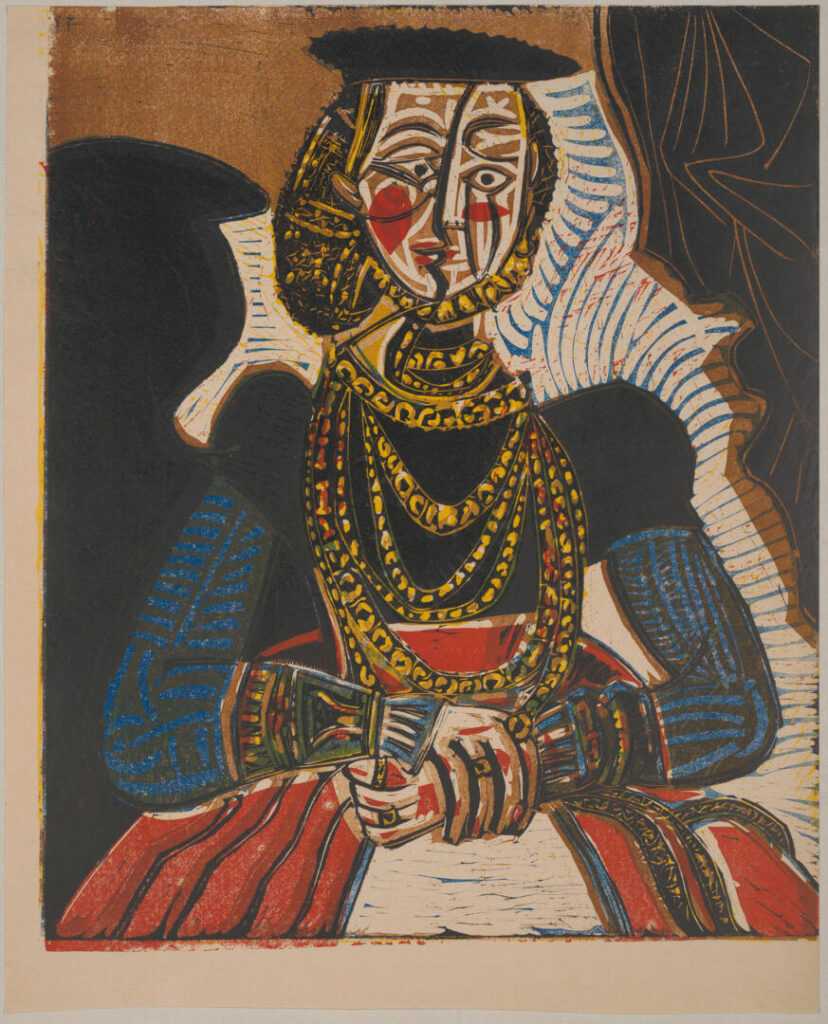Pablo Picasso
Spanish, 1881-1973
Portrait de jeune fille d’après Cranach le jeune II [Portrait of a Young Girl after Cranach the Younger II], 1958
Trial proof of all five blocks in their final states
Linocut on thin paper
Visual Description
This is a linocut print, measuring almost a foot and a half tall and one foot wide. In the center of the paper is a stylized depiction of a woman, laden with several bright gold necklaces and rings. She wears a dress with a jet-black bodice, black and blue patterned sleeves with blue, black, red, gold, and green decorations on the forearms, and a voluminous bright red skirt with a white center. A small black beret sits on top of her head and her hair is held in a gold hairnet. The woman’s facial features are outlined in black, her face is covered with thick white lines, and she has bright red cheeks. On the right side of the image is a black curtain with exaggerated folds. On the left side is a large black form that mirrors the shape of the woman’s figure.
In previous states, the image maintains the same format but differs in color. Various earlier states feature the image in the following color combinations: chocolate brown and white; black, white, sunshine yellow, reddish brown, and bright red; sunshine yellow, marigold, and white; dark tan, bright red, and crimson red; dark tan, navy blue, and marine blue; and black, white, dark tan, and bright red.
Extended Label Text
When Galerie Louise Leiris issued the finished linocut, the edition comprised fifty prints, numbered 1 to 50, and around fifteen artist’s proofs (identical to the numbered edition but for the artist’s use). This impression—a trial proof—is the final state before the published print. It is an early pull of that state so that Hidalgo Arnéra and Picasso could check that all the blocks were aligned and the colors were correct. Note another early trial proof displayed in the photograph of Picasso’s studio in the exhibition.
—————————————————————————————————————————————————————————-
Pablo Picasso
Español, 1881-1973
Portrait de jeune fille d’après Cranach le jeune II [Retrato de Una Joven según Cranach el Joven II], 1958
Prueba de ensayo de los cinco bloques en sus estados finales
Linograbado sobre papel fino
Descripción Visual
Esta es una impresión en linograbado, que mide casi un pie y medio de alto y un pie de ancho. En el centro del papel hay una representación estilizada de una mujer, cargada con varios collares y anillos de oro brillantes. Lleva un vestido con un corpiño negro azabache, mangas con patrones en negro y azul con decoraciones en azul, negro, rojo, dorado y verde en los antebrazos, y una voluminosa falda roja brillante con un centro blanco. Una pequeña boina negra se encuentra sobre su cabeza y su cabello está sujeto con una redecilla dorada. Los rasgos faciales de la mujer están delineados en negro, su rostro está cubierto de gruesas líneas blancas y tiene mejillas rojas brillantes. En el lado derecho de la imagen hay una cortina negra con pliegues exagerados. En el lado izquierdo hay una gran forma negra que refleja la figura de la mujer.
En estados anteriores, la imagen mantiene el mismo formato pero difiere en color. Varios estados anteriores presentan la imagen en las siguientes combinaciones de colores: marrón chocolate y blanco; negro, blanco, amarillo brillante, marrón rojizo y rojo brillante; amarillo brillante, caléndula y blanco; marrón oscuro, rojo brillante y rojo carmesí; marrón oscuro, azul marino y azul mar; y negro, blanco, marrón oscuro y rojo brillante.
Texto de Etiqueta Ampliado
Cuando la Galerie Louise Leiris publicó el linograbado terminado, la edición constaba de cincuenta impresiones, numeradas del 1 al 50, y alrededor de quince pruebas de artista (idénticas a la edición numerada pero para el uso del artista). Esta impresión, una prueba de ensayo, es el estado final antes de la impresión publicada. Es una tirada temprana de ese estado para que Hidalgo Arnéra y Picasso pudieran comprobar que todos los bloques estaban alineados y los colores eran correctos. Obsérvese otra prueba de ensayo temprana mostrada en la fotografía del estudio de Picasso en la exposición.




